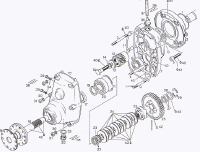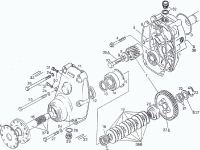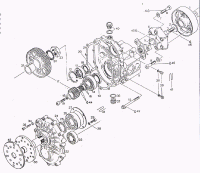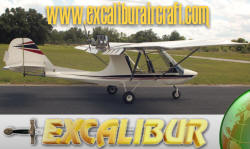
The A drive uses a 4 bolt adapter plate which bolts to the
engine and then the drive bolts to the adapter plate.
When they introduced the Dual CDI engines they modified engine,
which required a new drive called the provision "8" B drive. This
means the drive bolts
directly to the engine using an 8 bolt configuration. At the same
time they introduced the C drive and E drive.
The ABC and E’s of Rotax gear drives
The major difference in these drives are their "weight
ratings." That is do you need a 1/2 ton truck, a 1 ton truck? An A
or B drive can handle up to 3,000 kg cm2 of mass weight inertia.
The C and E drives can handle 6,000 kg cm 2 of mass weight
inertia.
So you have to find out how much your "truck load is"
-
Rotax
Service Information 11 UL 91 explains the process - in real life I
have found that a 3 blade IVO, 3 Blade GSC, 3 Blade Powerfin, 4
blade Ultra prop up to 66 inch can be loaded into the "1/2 ton" A
or B box - with the Warp Drive 3 blades being too heavy.
Two blade props by the above manufacturers can be used up to 68
inches, if in doubt contact your manufacturer!!!!
Another consideration is what type of plane you fly. If you fly
a plane that uses a short prop like the Hornet, or older model
Challengers, you will be spinning a smaller prop faster.
This is
generally less efficient and noisier. While if you are
flying anything using a 2.58 to 1 reduction drive you will be
flying on 60 to 68 inch props. Spinning them slower, quieter, and
more efficiently!
The A and B drives ratios
are 2.0:1, 2.238:1 and 2.58:1.
Prop selection - length vs pitch 2 blade vs 3 blade is
another story!
The C and E drives
These drives can handle twice as much weight, and are
available in ratios of 2.62:1, 3.0:1, 3.47:1 and 4.0:1. These
drives are used with larger diameter props, or more blades.
For
example a WW 1 replica fighter using a 582 engine could swing a
very large two blade prop very slowly using a 4 to 1 reduction
drive. This would be more authentic looking, be very efficient and
quiet. But this combination would not work well on a very fast
plane, or one with low ground clearance.
Or a trike could use a 6 blade prop, with less length and more
pitch for the same reasons. While some in the industry may
argue that this allows the use of smaller engines to be used, with
the larger ratio.
Real life has shown that a prop and its power
are mated with the craft. That is while you may find some craft
can fly on less power, using a larger redrive ratio - it is always
better to have MORE power.
Type A gear boxes were used through 1989 on most UL series
engines. On the twin cylinder
engines, the type A gear box mounts to the crankcase via an
adapter plate. The adapter mounts to the crankcase with 4 allen
head bolts.
These crankcases are referred to as "provision 4." In
1983 and part of ‘84, a 3-bolt case was on the A drive this was
later updated to the 4 bolt pattern, after shearing of the top
bolt on the case was reported. On the 4 bolt adapter plates you
can change the direction of the drive 180 degrees by rotating the
adapter plate.
In the late 80's early 90's the new provision 8 series of
engines and drives was introduced. The type B gear
box which is internally the same as type A, attaches to the
provision 8 case in either up or down configuration without the
need of an adapter. They both dampen torsional vibration via a
system of bevel washers and a dog hub/dog gear arrangement.
Type A and B gear boxes are not interchangeable. "A" fits
provision 4 and "B" fits provision 8.
Type C gear boxes are totally different internally and
externally. They dampen torsional vibration via a rubber "Hardy
Disc" rather than bevel washers. They also weigh about 10
pounds more and are more expensive.
Type E gear boxes dampen torsional vibration identically as the
C unit. They are similar internally, but not identical. The
functional difference is the addition of an electric start unit to
the Type E. Type C and E fit provision 8 cases only. If you are
going to be using the B drive and an electric start, or a C drive
and an electric start you are better to buy the E drive.
|



